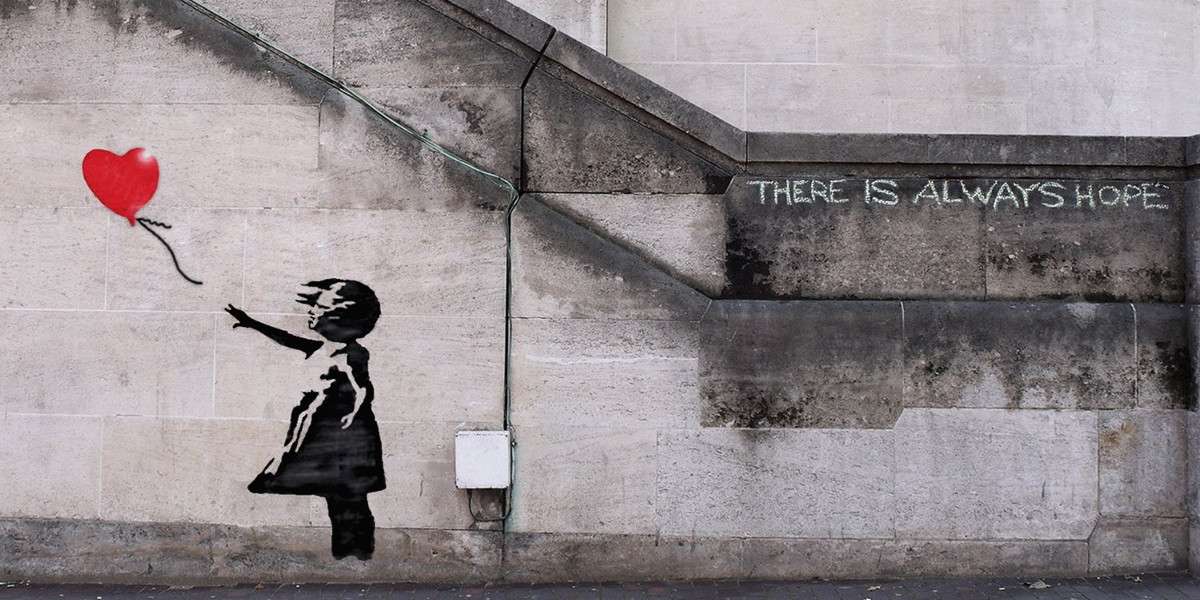
Banksy – Girl with a Balloon – Image courtesy of Banksy
In a modern street art world that appears to be placing a focal point on muralism and commercially successful pieces through which a profit is a distinct possibility, the stencil graffiti remain as arguably the most authentic and rebellious form of urban art to date. This old-school technique is definitely the closest contemporary method that honors all the aspects of the original street art scene without compromising any of its norms. It offers instant recognizability, speed, efficiency and neatness – all of which come very in handy when a person is creating an illegal graffiti and time seems to be an essential factor. In its very core, a stencil is different from any mural or a piece of marketable street art – it stays clear of the spotlight and prefers functioning in the shadows, has a practical tendency of staying small and to the point, avoids too much coloring and it never lost its defiant punch that made it famous in the first place. Stencils can also be perceived as an evidence that one does not need to paint big in order to be successful – by far more important factors than size are relevance and placement of the piece. This quick and relatively easy technique of street art making is also popular because of its cheapness – all a person needs in order to make a stencil graffiti is a piece of cardboard, a knife and a can of spray paint, making the artistic vision placed behind the piece the only challenging bit in the entire process. As is the case with the rest of the genuine urban art scene, stencil graffiti as well have but one purpose to serve in their often short-lived lifespans – to communicate an uncompromised and unfiltered message with accidental bystanders.
The method of stencil graffiti painting has been present in the world of street art ever since this technique emerged during the 1970s in the metropolises around Europe and the United States. Those who produced and utilized stencils over the years had many motivations, but all of them shared the same appreciation of the publicity that this type of artwork can receive. Due to the unique method of stencil making, the same piece can be reproduced over and over again, allowing the design to stay uniform throughout its use. This makes stencil graffiti the most efficient tagging method, both from a quickness and neatness standpoint, allowing the practitioner to easily establish a reputation with the audience of the streets. All of the above-mentioned aspects and characteristics of this medium made it extremely popular with illegal street art making that was exploding during the 1980s, although today’s adaptations of the technique are a bit different in that regard. This underground medium has seen its fair share of talented artists over the years, many of whom we will introduce you to in this article, all in an attempt to explain both the history and the nature of the often overlooked stencil graffiti which is undoubtedly an essential segment of the street art culture.
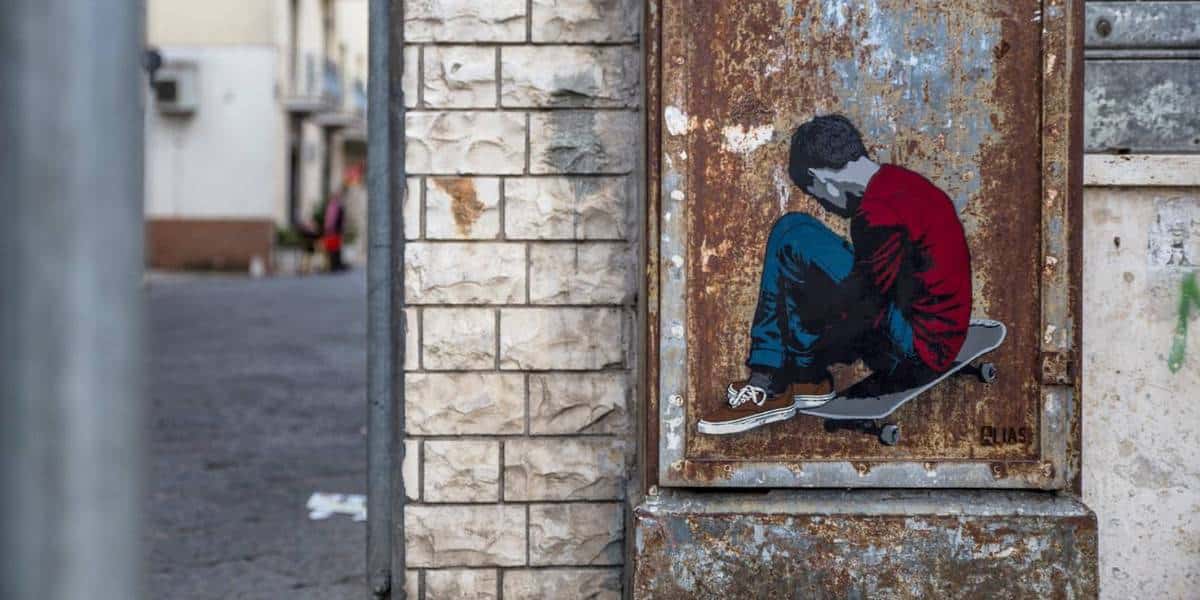
Alias – Untitled stencil in Italy, 2016- Image courtesy of Alias
History of the Genre
A little-known fact is that the concept of spraying a quick image onto a surface via a pattern of some sort can actually be attributed to the United States Army – soldiers used this tagging method in order to mark equipment belonging to different divisions. Furthermore, during conflict times, the army would mark directions and information on urban surfaces of war-torn towns, making stencils in order to enable normal functioning of the soldiers who needed to know where to station themselves. Besides marking the buildings and equipment with stencils, the World War II American soldiers would often spray tag their tanks and artillery with motifs of angels or skulls, all with goals of scaring the enemy and raising morale. After the World War II came to an end, stencils remained the most efficient tool of on-the-spot organization within the army, but also became a popular method for civilians to defy the current political situations and demand changes. Many European cities were covered with rebellious stencils, all of whom were protesting against the ruling class and displaying anti-government statements. This early form of street stencils was highly dangerous and popular, but was still far from an artistic expression – they were simply the most efficient way to protest against something with solid chances of getting away with it.

John Fekner – Broken Promises – Image via wikipedia.org
The European early stencil situation eventually managed to migrate over the Atlantic and arrive on the shores of the United States in the 1960s. Back then, social turmoil could be found all over the USA , with public unrest over various civil aspects being present in middle and lower circles of society. This instability gave rise to anti-establishment movements directed by punk rock bands such as Black Flag and Crass. In an attempt to self-promote their songs and simultaneously show their anti-government opinions, these bands covered their punk venues with stencils, presenting their logos and names, lyrics and logos. Often used as a reference for the true artistic beginning of this medium is the year of 1968 when John Fekner placed his work outdoors for the very first time. He worked in the Big Apple and his graffiti became a segment of the underground culture overnight – John was the only one of his fellow urban artists to use the stencil and the public never saw anything like it before he started working in this method. One of Fekner’s best artworks was a stencil titled Wheels Over Indian Trails and it greeted motorists and international travelers arriving in New York City from a suitable location at the Pulaski Bridge Queens Midtown Tunnel. Since it was painted over by the artist himself in the year of 1990, the remembrance of this graffiti nowadays serves as a path down memory lane, leading to a time when stencils were the freshest segment of the urban art scene. Parallelly with Fekner and his development of the stencil, the French urban interventionist Ernest Pignon-Ernest also worked on his own take on the medium – his stenciled silhouette of a nuclear bomb victim was spray painted in 1966, in a town of Vaucluse. However, besides John Fekner and Ernest Pignon-Ernest, the stencils did not manage to find too many noteworthy individuals interested enough to take the medium a step further and improve it, subsequently impacting the medium’s natural evolution. Fortunately, this all changed in the early 1980s.
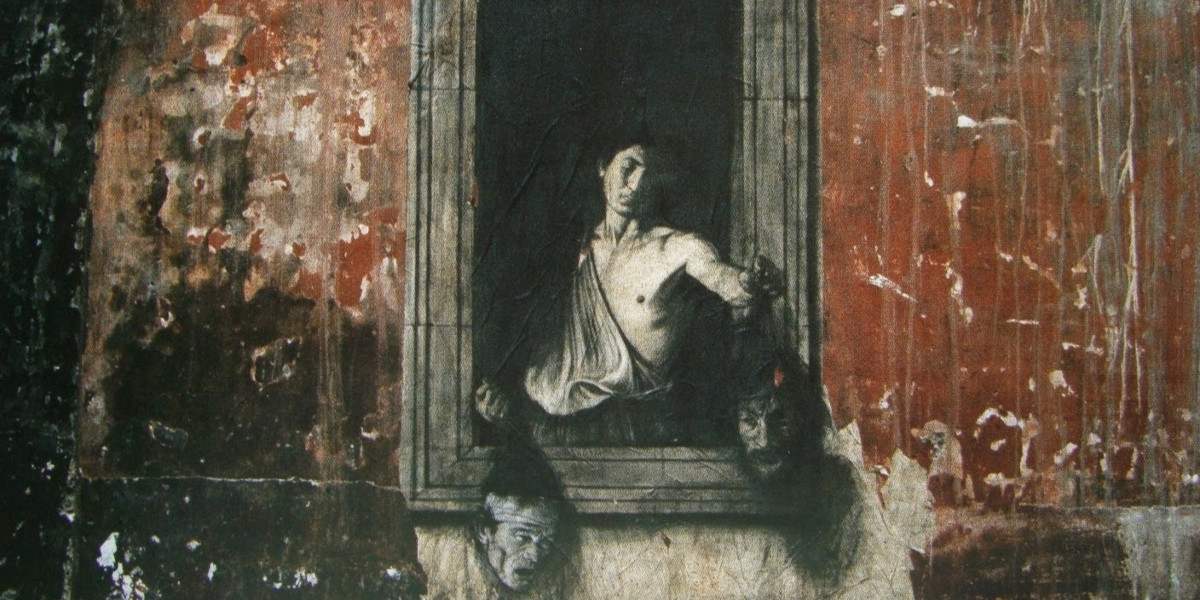
Ernest Pignon-Ernest – David et Goliath, 1988 – Image via millepiani.org
Blek le Rat
Blek le Rat, the stencil’s most important early practitioner, sprayed his first pieces of this style in 1981, placing them around Paris. He is often described as the father of stencil graffiti and learned a lot about his practice by studying fine art and architecture at the prestigious École Des Beaux Arts in Paris. He was heavily influenced by the New York street art scene which he inspected during a visit to the Big Apple as a student, developing an overwhelming fascination with this art form. However, Blek desired to create something of his own and new, something that would distinguish him from the rest of the urban painters and establish his reputation as a leading author of graffiti. So he started making stencils of rats, distributing his pieces around the City of Light. The utilization of pre-stenciled posters and images allowed the application of paint to be a lot speedier, which proved quite useful since Rat’s activities were illegal at the time. Soon, he acquired the famous nickname thanks to the animals he depicted – this was Blek’s intention from the start, as RAT is an actual anagram for ART and, in his opinion, rats symbolized both freedom and the spread of art throughout the city as an invasion. He was making large murals as well as self-portraits, always accompanied by rats which in return became a trademark and a unique tag. He created socially engaged artworks, intended to bring attention to global problems, often depicting marginalized individuals opposed to large oppressive groups. Blek is credited as the first person to transform stencil from basic lettering into systematical imagery, as well as the first one to introduce the life-sized pieces of this method. Over the years, it seems that the subject of Blek’s depictions has changed a bit – as he matured, he became more focused on questions that regard politics and environmental problems. Blek le Rat will prove to be a key moment in stencil’s transition to street form and many of his works are yet to be visually surpassed. He is also one of the most referenced artists by other artists as mostly all of the younger stencil makers owe their techniques to Blek le Rat.
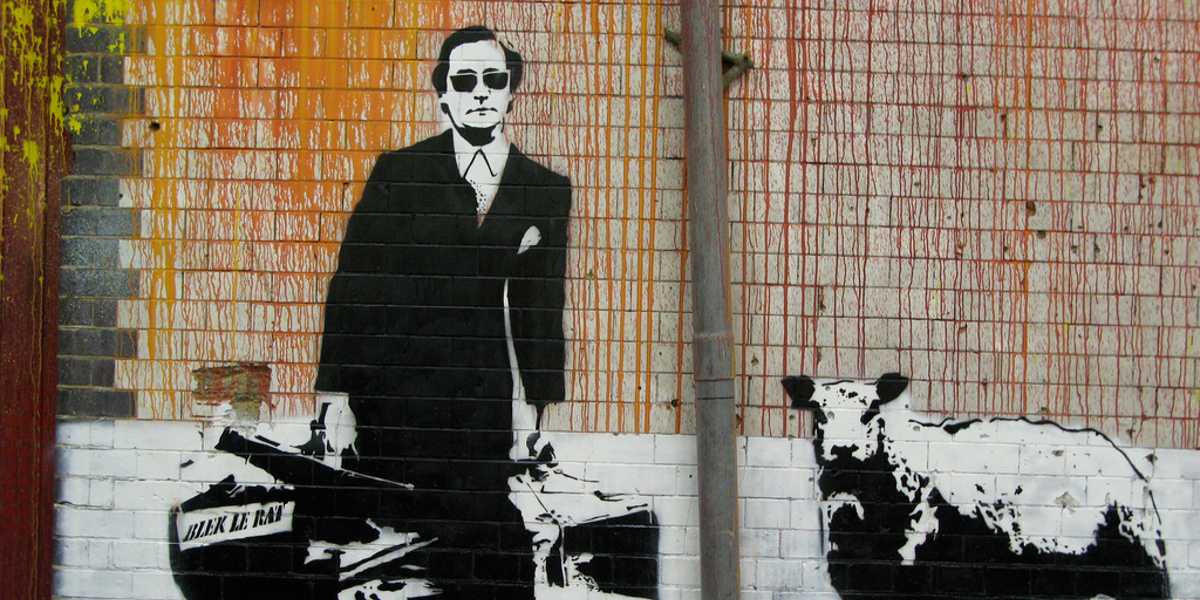
Blek le Rat – Untitled Autoportrait – Image via isupportstreetart.com
The Time Between Blek and Modern Popularity
Although being the premier spot, Europe was not the only location where stencil was being developed. Using his trusted camera, Australian photographer Rennie Ellis documented some of the earliest examples of stencil art to appear in Sydney and Melbourne, excellently archiving them in a 1985 book The All New Australian Graffiti. Through his correspondence with the American photographer Charles Gatewood, Ellis made a conclusion that the Australian stencil scene was nothing like the one present in the United States, unlike the case was with the subway-style graffiti which was nothing more than a copy of a well-established New York tradition. Ellis’ extensive work is quite important as most of Australia’s early stencils have long despaired whilst their authors were in most cases anonymous. Despite being present in all bigger street art scene around the globe, stencil still did not manage to confirm the status of a prime technique, falling far behind the popularity that standard graffiti enjoyed.
Fortunately for the young medium, the Internet phenomenon of the late 1990s helped stencil to finally confirm its rightful place in the street art Hall of Fame. As modern artists started seeking expressive options that were not overused in the past, many of them believed stencil to be the best choice. Since then, many of the method’s practitioners emerged and together built what can easily be considered the golden age of this medium, allowing stencil graffiti painting to reach its maximum level of popularity in both the eyes of the artists and the public. However, before we start revealing the crucial names of today’s scene, it must be noted that stencil graffiti is still illegal in some jurisdictions and states, as well as that this is the reason behind the decisions made by many of the members of this subculture to shroud their identities in aliases. This kind of mystery surrounding stencils became a key part of its subculture, making it into one of the most secretive art form of all modern movements.
Modern Practitioners
Today, stencils enjoy quite a reputation and, although they have a limited number of practitioners when compared to other street art techniques, they are the subject of great respect from both artists and the public. It should be noted that the stencil community is a tight one and most of the artists on this list are somehow connected to each other, either working and collaborating together, or exhibiting their works and forming festivals with the goal of bringing further popularity to their medium.
Banksy
Being both the most controversial street artist in the world and the most successful practitioner of the stencil, Banksy’s name does not require too much introduction and his presence on this list comes as no surprise. What makes this artist so great is the fact Banksy managed to create an entire art subculture devoted to his works. Successfully keeping his identity a mystery for over twenty years, this artist is a genuine legend of stencils and serves as an inspiration to all of the aspiring street artists around the world. His work is equally powerful as it is controversial, known for the ability to never leave anyone unfazed. Inspired from the start by the works of Blek le Rat, Banksy began his explorations of boundaries present in the stencil technique by recycling and realizing Blek’s old ideas. This occurred in the 1990s as he began to hang around a graffiti crew in Bristol by the name of DryBreadZ crew or DBZ. During an attempted escape from the pursuing police officer who chased him for vandalizing public spaces, Banksy saw stencil letters on a truck whilst hiding underneath a garbage truck. Realizing the stencil method would allow him a much faster way of leaving his mark, he decided to transform his output to this medium, hoping that stenciling would prove to be his new graffiti type. Since then, his stencils have been conveying powerful messages through vivid visuals that are often satirical, relying on dark humor to spread Banksy’s opinions on topics such as art, philosophy and politics. By the early 2000s, he relocated to London, where he began to gain notoriety and even worked on a series of international exhibitions, presenting the world with the unique simplicity and roughness his pieces are praised for. Besides using urban surfaces, he also uses the Internet to his advantage and many of his unique works can be found exclusively online. He also combines stencils with different mediums, such as spray-paint or found objects that someone left for good on the streets. For that reason, some have claimed that he is much better described as an installation artist, but since stencils are the core of his work, this categorization of Banksy has failed in its attempt to place him in the installation class.
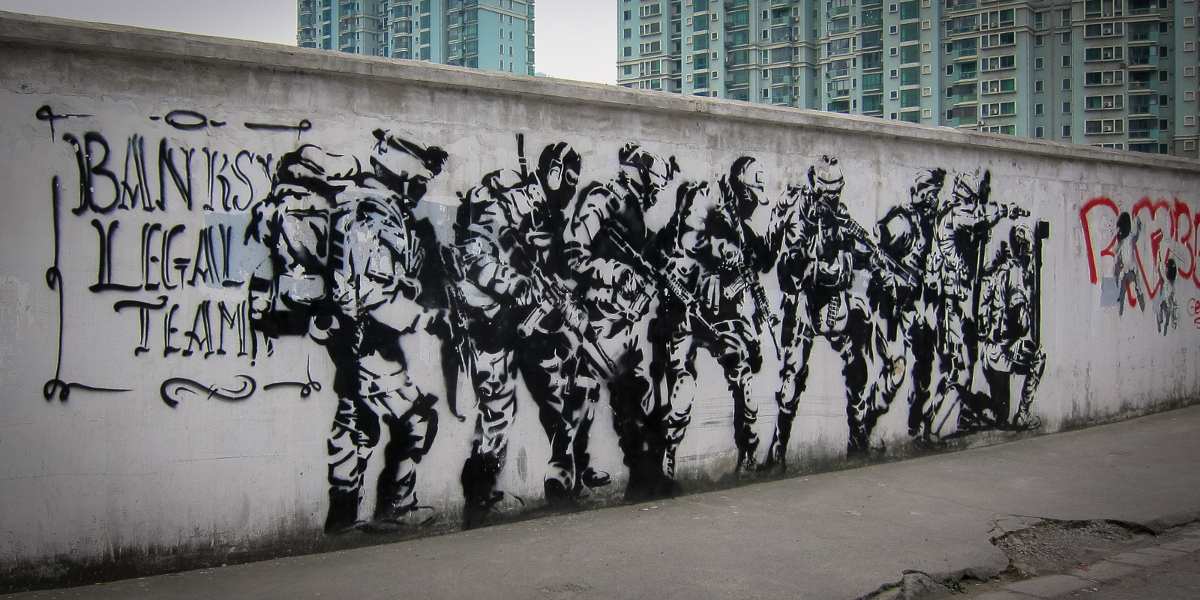
Banksy – Legal Team, Shanghai – Image via urbanpresents.net
Dolk
Dolk is the pseudonym for Norway’s most recognized graffiti artist and a crucial stencil practitioner. Constructing his alias with a word meaning dagger in Norwegian, this artist’s motives are often pop-cultural references put into a humoristic or derogatory context. Not limiting his workspace to just his native town of Bergen, Dolk’s graffiti can be found on the walls of cities like Berlin, Copenhagen, Barcelona, Oslo, Lisbon, Stockholm, London, Prague and Melbourne. His explorations of the stencil art started in the year of 2003 after Dolk was attracted to the similarities between this medium and the field of graphic design which he studied in Australia. By his own acclaim, the main source of inspiration that pushed him to stencils were the works of Banksy – Dolk implemented this artist’s style into his own works so much that many of his graffiti have been attributed to the legendary Banksy by mistake. It should also be noted that Dolk is one of those rare urban artists that was among the first to make the transition from the streets to gallery spaces – he stepped into the world of exhibitions in the year of 2006, ever since he successfully displayed his graffiti in galleries. Although often criticized for this decision by fellow stencil painters, Dolk made this choice because he wanted to take his art into more legal forms in order to participate in festivals around the world. Over the years, Dolk has proved to be everything but ordinary in his street art endeavors – in 2010, he and a fellow stencil painter Pøbel decorated the walls in the exercise yard located in Halden prison, whilst the pair was also commissioned to put their art up at the main railway station in the Norwegian cities of Oslo and Trondheim. We should also state that Dolk recently stopped working in stencils but his achievements in this medium nevertheless make him one of the most important artists of this style.
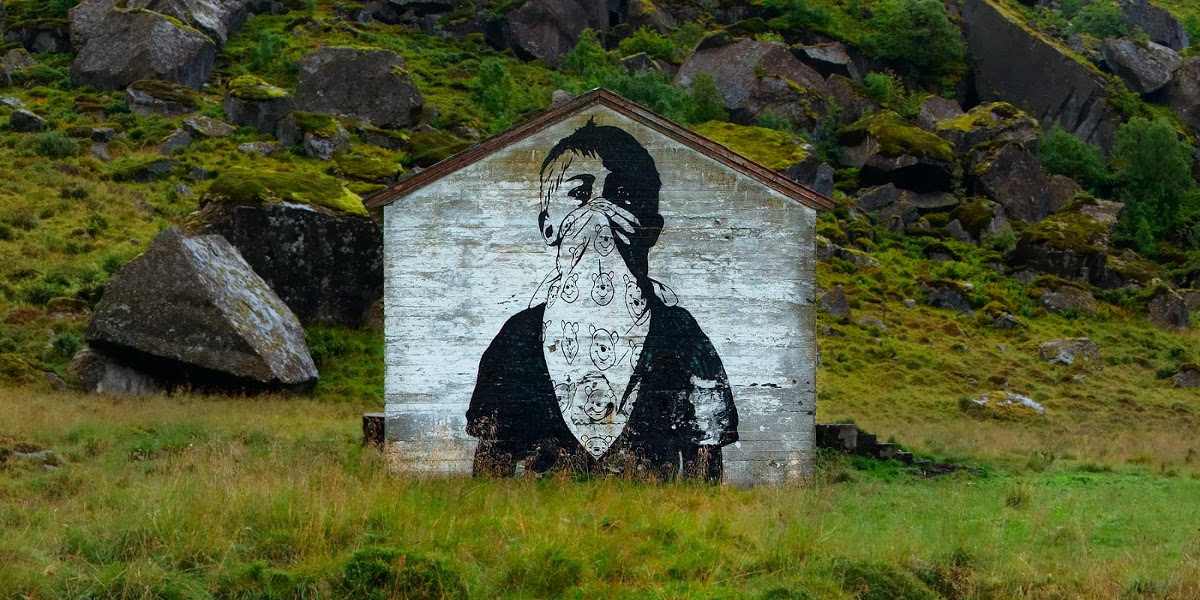
Dolk – Untitled – Image courtesy of Dolk
Pøbel
Another Norwegian artist on this list, Pøbel is a pseudonymous street artist based in Stavanger whose name and age are completely unknown. With stencils being the focal point of his work, Pøbel mostly authors sight gags with interesting humoristic twists and contexts. For example, one piece portrays superheroes such as Batman and Superman in decrepit old age, putting their superior nature in a questionable state. He is mostly known for his collaborations with the Dolk – besides the aforementioned legal decorations of prison and train stations, the duo also worked together on the Getto spedalsk (Ghetto leperous) project from 2008. In it, Pøbel and Dolk decorated abandoned buildings in the Lofoten islands in the north of Norway. Keeping a much lower profile then Dolk, Pøbel is one of the foremost stencil artists in Europe, with his street works documented in numerous books on the subject. Most recently, Pøbel spray-painted the symbolic mute icon on Donald Trump’s star in Los Angeles’s Walk of Fame, effectively causing various public reactions around the world.

Pøbel – Ice Ice Baby – Image via psycholnets.com
Evol
With a degree in product design, German street artist Evol is quite a unique entry on this list. Over the years, he became famous for his urban installations and paintings mostly made using reclaimed cardboard. Usually choosing decaying urban buildings that were far ago abandoned, Evol searches to explore the lives of the ordinary individuals from modern societies. Known for his unusual combination of pasting paper, stenciling, and painting, Evol adds tears, markings and folds to buildings and makes these elements seem as genuine as the facades of the structures. Through his work, this artist also tries to establish a narrative or suggestive of the turbulent history of Berlin, believing the buildings to be the true carriers of history.

Evol – One of the Stencil Apartment Buildings – Image courtesy of Evol
Icy & Sot
Icy (born in 1985) and Sot (born in 1991) are Iran’s most famous stencil artists, originally from the town of Tabriz and currently based in Brooklyn, New York. These painters are actually brothers and have been active in the stencil scene since the year of 2006, developing a rich portfolio of urban stencils that address global social issues. They initially started by putting up small stenciled works on the streets of Tabriz, posting the resulting images online. They became famous after a 2011 exhibition held in Amsterdam – since then, Icy & Sot were household names of the stencil world, with their work widely respected and appreciated. The duo has been concentrating on various issues on a worldwide level, tackling problems concerning human rights, ecological justice, social and political matters. They use public art to envision a world freed from borders, war and gun violence. Icy & Sot are as well artists of the gallery, not limiting themselves only to the streets.
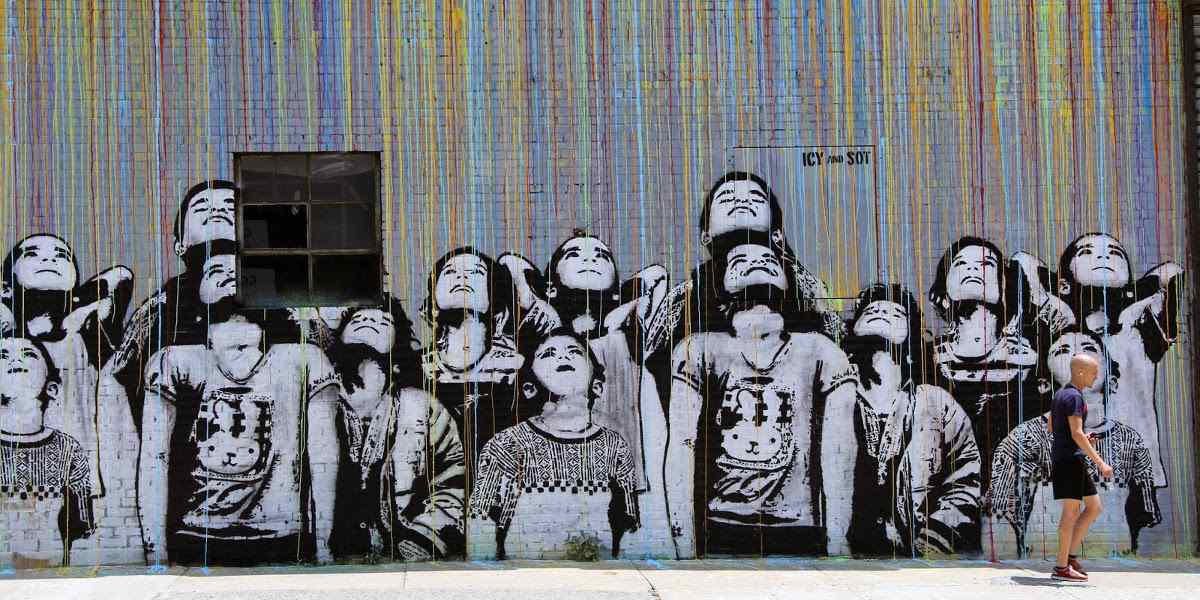
Icy & Sot – Untitled piece in NYC – Image via goblinmag.com
Boxi
Boxi is a Berlin-based stencil artist also known for his multilayered works, but this stencil painter caught the public eye for his life-size pieces which feel almost real. Boxi was born 1974 in Kent, England, and attended studies at the London St. Martins School of Art where he received a BA Fine Arts degree in painting in 1996. Boxi creates hand cut stencils with multiple layers, putting a special emphasis on photography-like details which make his pieces one of a kind. His work typically conveys a haunting, post-apocalyptic world, but there are frequently charming touches of humanity. Like Dolk, Boxi’s stencil output is displayed on both the street and inside galleries as this artist also believes that urban art can function inside a confined formal space.
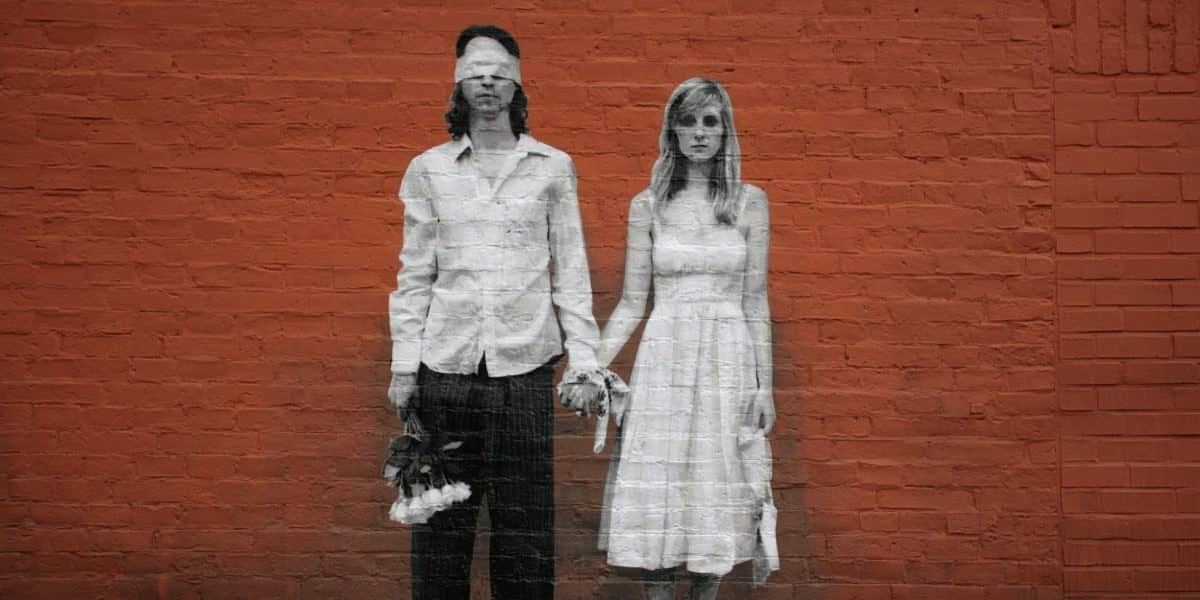
Boxi – To die for, Luneburg, 2009 – Image via wikipedia.org
SAMINA
SAMINA is definitely one of the more versatile artists on this list as he has worked in many other mediums besides stenciling, even including architecture. When he was 14 years of age, he started spreading stickers around the streets and discreetly made his debut in the world of street art. For several years after that, he accompanied the growth of the stencil phenomenon and was also growing as a self-taught artist, learning all he did on the go. Since 2010, SAMINA felt capable of producing larger and more consistent work, subsequently making him more noticed and appreciated by the street art public. By working in unique visuals, this artist put together a private language of his own, using stencil techniques with other art forms from such as graphic design, painting and architecture.

SAMINA – João Samina for WIP – Image via stick2target.com
STRØK
Anders Gjennestad, aka STRØK, is yet another talented stencil artist coming from Norway. Putting a strong emphasis on details, Berlin-based STRØK demands utmost perfection from his pieces as he insists they must look like the photographs he uses for inspiration. Out of all the artists mentioned here, STRØK can easily be the one who plans his stencils in advance the most – besides preparing and visualizing the design, he also works hard on making the perfect photo that serves as an inspiration and a model. Like most other stencil painters, STRØK is a self-taught artist and has got himself in today’s situation by working hard and honing his skills to perfection. He is also quite systematic as his method takes into account how well the materials will age, survive various weather conditions and how their texture will degrade over time. STRØK’s visuals are based on a fantastic universe, an alternative world where there are no familiar laws of physics on which we depend so much. STRØK as well adds multiple layers to his work but what makes him unique is that he often does not tag his work, allowing the aesthetics and the style to point to his direction. This way, he also states that street art is not anyone’s property and that it belongs to the public. As a few other entries on this list, STRØK as well mainly works on the streets, but his indoors multi-layered artwork has been exhibited in many galleries around Europe.

STRØK – Untitled – Image via norwegianstreetart.com
Emess
Emess is a German artist whom many describe as a crucial figure in the European urban art scene. Just like the case is with most of his stencil colleagues, Emess is as well motivated by political questions. He attempts to confront the issues which most people would rather ignore and sweep under the rug, pretending that they are not a true problem. Emess likes to state that many of his topics do not have an easy and simple solution, but should nevertheless be somehow tackled. He is also appreciated for his use of humor and a keen way of catching viewers off guard by allowing the attention to gradually be drawn to the subject. Besides working in stencils, this artist also experiments with sculptural objects and large scale murals, as well as delicate printing. In his most successful stencil series to date, Emess borrows portraits of known personalities and puts them in a new shared context, presenting depictions of Che Guevara, Nelson Mandela, Gaddhafi, JFK, etc. The goal of the project was to show how easily the line between a rebel and a dictator can be shifted and dependent from a personal perspective. Emess sees no difference between the street or the gallery space – his work is designed to reach an audience whatever the situation of witnessing it may be.
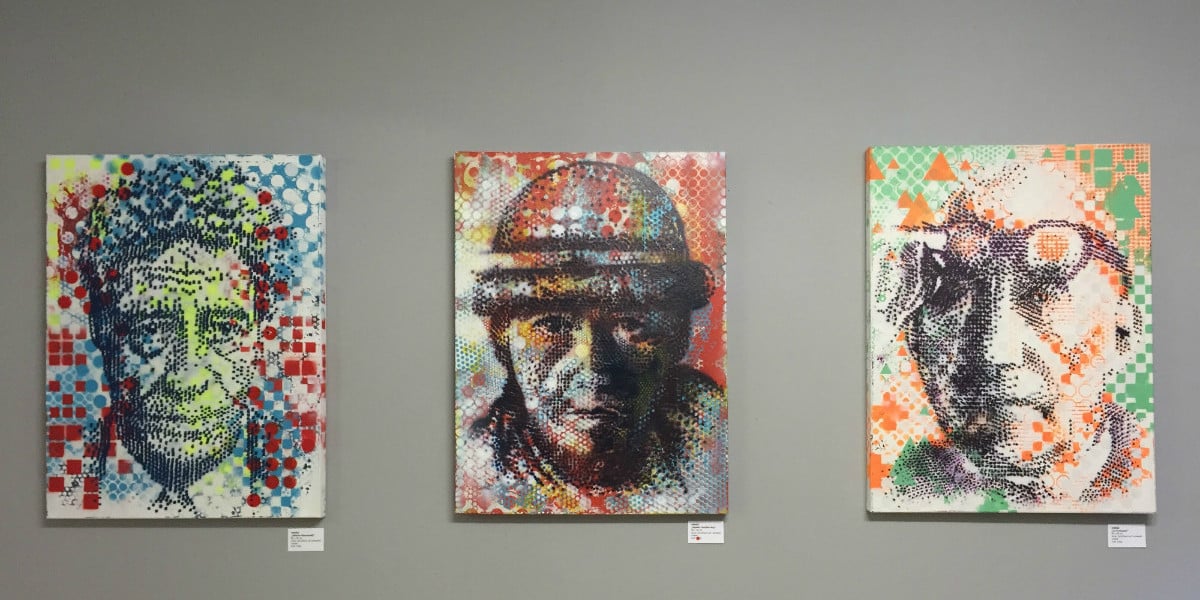
Emess – Multiple Stencil Pieces, 2016 – Image via prettyportal.de
Sten & Lex
Another duo on our list is a collaboration between two Italian street artists Sten and Lex, both of whom were born in 1982. These artists have been doing stencils since 2000/2001 and back then, stencils were not nearly as popular in Italy as was the case in the rest of Europe and the United States – for that reason, Sten & Lex have often been portrayed by the Italian media as pioneers of stencil graffiti. This duo is not a product of any kind of art academy or design institution that dictated the way they think and create, but they are also untypical as their background is far from any standard writing and graffiti past common in the world of urban art. With varied themes and subjects, Sten & Lex are famous for their alternative way of making stencils – together, they’ve introduced the halftone stencil technique, a method in which the greater part of the portraits is composed of thousands of thin lines. Today, their work is part of the urban landscapes in London, Paris, Barcelona, New York, and in their hometown of Rome.
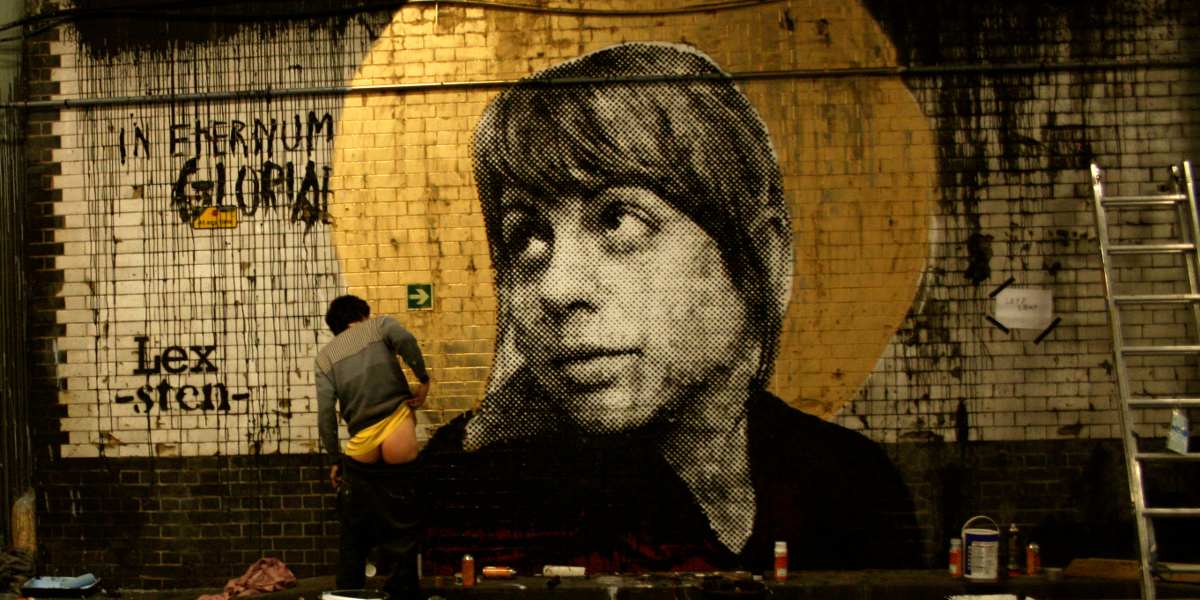
Sten & Lex – A piece for Cans Festival, London 2008 – Image via wikipedia.org
Rero
Often very critical in his approach, French street artist Rero employs a crude black and white style to investigate the fundamental values of our existence – freedom, progress and censorship. Rero is interested in all topics concerning the endangerment of principles that are responsible for putting the liberty of mankind at risk. This artist treats his stencils as capable of raising an alarm within societies, warning us that our lives might be overcome by passiveness and overconsumption. In a sense, Rero holds collective therapy sessions by presenting the audience with a visual cleanliness of an explicit, didactic message. Perhaps a bit more conceptual than the rest of the stencil artists on this list, Rero might be the closest thing to a poet modern street art scene has in its ranks.
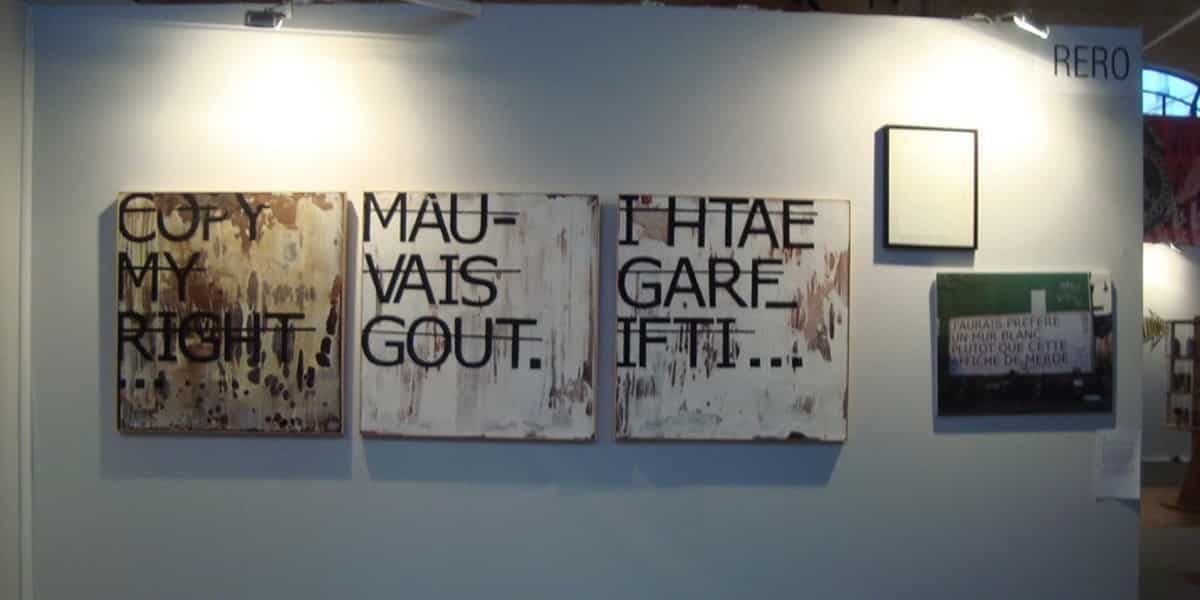
Rero – Multiple stencils – Image via Rero
Alias
An artist that is extremely capable of tugging the emotional strings within the hearts of his audience, Alias’ work mainly represents children and teenagers, depicted alone and confronted with harsh situations. Using the black and white graphically stylized figures with rare touches of red color, Alias presents us with heartbreaking images such as a scene with a gunned down child or a crying kid hiding his face as he returns from school. His art is very personal and focuses on one individual at a time, presenting us with their small story in an epic tale we call life. When it comes to Alias’ art, it’s all about the quiet introspection – he investigates how individuals are personally changed and affected by their unfair environments. By isolating people from the social background or situation they are in, Alias makes them mysterious and familiar at the same time, triggering a direct emotional impact on the viewers. He wants us to show compassion towards his mistreated subjects, to understand how often the existence of loneliness and personal crisis can be found all around us. While a lot of street artists try to make their pieces big and highly noticeable, Alias creates in an opposite direction – his stencil paintings are quite discreet. An integral part of Alias’ portfolio is the location where he decides to place the pieces – he carefully chooses specific spots and objects where the stencils are going to take place, as the location of the work is as crucial as the composition itself. By making sure the place is perfect, this artist makes sure that the stencil reaches the highest level of emotionality. Although his art is often perceived as politically fueled and in that regard similar to Banksy’s stencils, Alias does not seek to expand his messages on anything larger than the matter at hand, insisting that his goal is to make us aware and compassionate towards individual injustices.
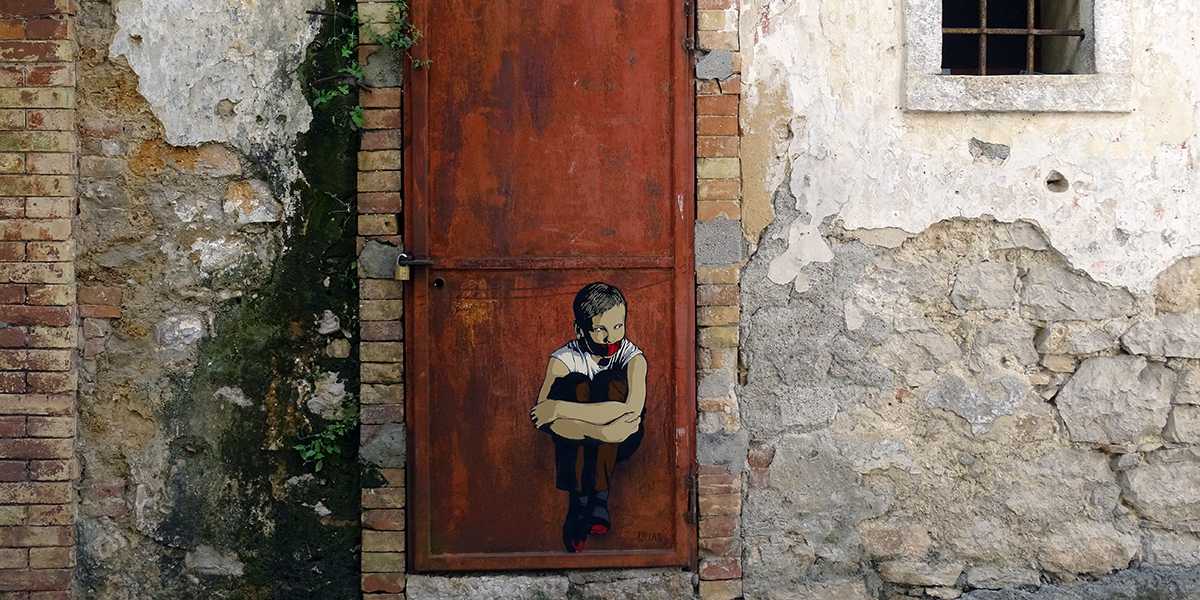
Alias – Untitled stencil in Italy, 2016- Image courtesy of Alias
How to Make a Stencil Piece
As is the case with all mediums, with the exclusion of architecture, stencil also has different degrees of difficulty, ranging from relatively simple to breathtakingly difficult, leaving to the artist to decide how much complexity there should be in their piece. By lowering the said degree, one can easily master this technique by starting with simple stencils, slowly upgrading his visuals to a more demanding level as his skill gets better through practice. You can start with mere hearts or circles and slowly make your way to the complicated city scenes or realistic portraits. We will now present a guide on how to make a stencil piece, from coming up with an idea to actually pasting it upon a wall. Before you start, you need to figure out one crucial thing – is the stencil the right medium for what you are trying to achieve? Based on your goals and designs, you may want to go with another art form as many of them are far less restrictive than this one. But if you believe the stencil magic is the way to go, then this is what you need to do.
First of all, and this should come as no surprise, you need an idea. Like any great film, painting or song, it needs an idea behind it, a vision that it’s trying to achieve. After you are certain the idea is the right one to pursue, it’s smart to plan it out a bit. Unlike compulsive improvisation popular with some other forms, such instinct-driven concepts have no place in stencil making. This is a long process with many stages, it can not be made by figuring out things as you go. Primarily, the next thing on your to-do list after establishing an idea is deciding which size the stencil is going to be – if it’s going to be a small format, including small details might not be such a good idea. Another thing you may want to decide prior to starting is how much color you want in your stencil. Depending on that, you may want to use multiple stencils and each will be used with its own layer of color. Next up, you need a scheme, a drawing of how the finished stencil is supposed to look. Experiment with new patterns or attempt to hone a design that you had intended from the very start.
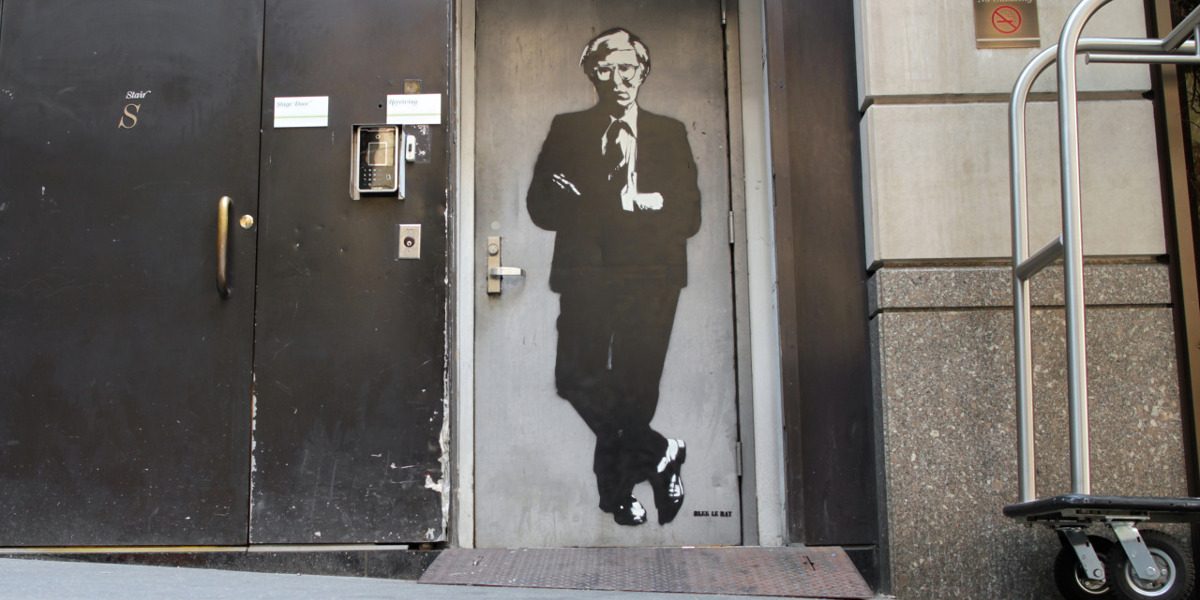
Blek le Rat – Untitled – Image via thedustyrebel.com
The next choice stencil artists make is a bit harder than the ones above – they need to decide which material will they be using. This choice is usually made based on two factors. There is a variety of materials that are suitable as stencils, but you need to consider how much use the stencil will have and the ease with which you can work with the material. Cardboard or foam board are good for large, simple stencils on flat surfaces with fewer details, whilst paper is similar, but it can function either on flat or rounded surfaces. If you are a capable craftsman, plastic may be your wisest choice – a bit harder to manipulate, plastic or clear acetate are good if creating reusable stencils for either flat or rounded surfaces. An alternative to plastic is frisket film but this is a far less popular choice. When you decide which material will be the right one for your future stencil, you draw up a clear image, with clean lines and good contrast. And then you carefully cut it, following the marks outlined by your marker. Be careful with altering the image as the stencil needs to remain a single piece.
Finally, attach the paper with the stencil image to the stencil material. There are a number of ways to which you can attach the paper – either tape it in place, attach it with spray adhesive or transfer the image to the stencil material using tracing paper (the best option if you work in cardboard). Then find a sharp utility blade and delicately cut out the unneeded portions of the stencil. In other words, you are trying to cut out the areas of the material where you want the paint to appear. After that, you are good to go – just be careful that the stencil is lying flat on the surface when you begin to spay the paint. Otherwise, the paint will get underneath and make the design unrecognizable. Also be careful not to apply the paint so thickly that it pools or puddles, for this will occur despite the stillness of the tools. Keep the application process fast and, when you are finished, remove the stencil and move on, acting as if you were Blek the Ret himself.
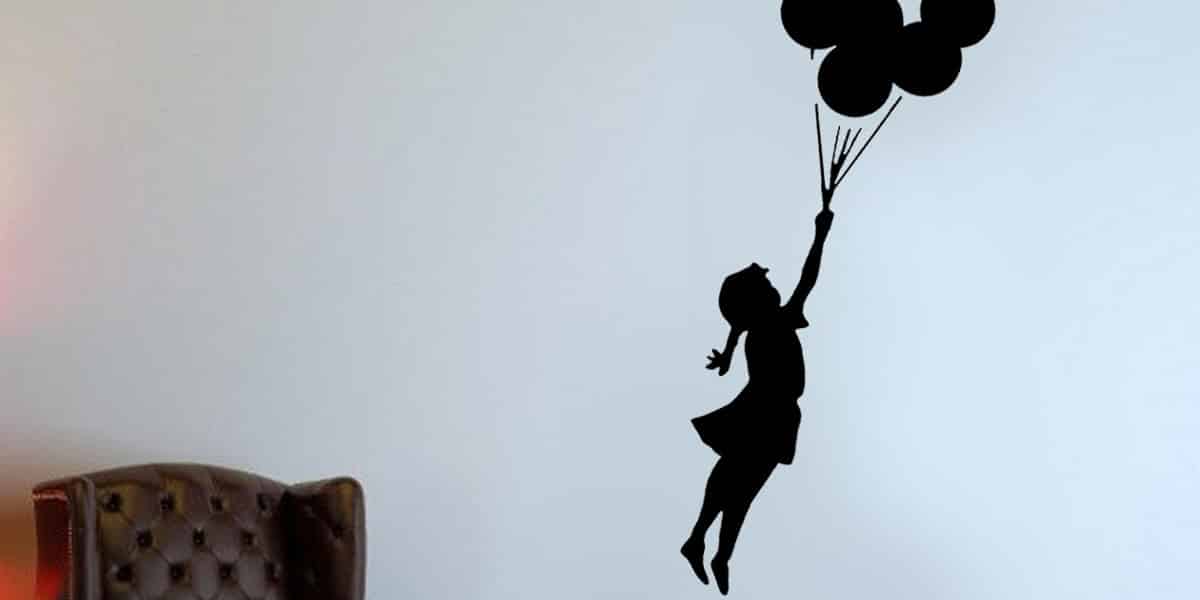
Banksy – Flying Balloon Girl – Image via idealstencils.co.uk
Stencils Nowadays
When you analyze the current state of the stenciling technique, it seems that this medium is nowadays enjoying the highest level of popularity in its relatively short history. With numerous artists tirelessly developing and establishing new norms, stencils are now well-respected by both the art community and the public. If we were to look upon the modern circumstances surrounding stenciling from a pre or early post-Blek le Rat-era, this widespreadness and popularity would not only come as a surprise but rather as a legitimate shock. In its original core, stencils are an outlaw medium, invented only in order to be sprayed fast enough for the painter to have the time to get away from the authorities, exposing himself to as little risk as possible. Back then, Blek le Rat was not treated as today’s stencil painters, with the glamor, attention and respect for their artistic contributions – instead, he was treated as a felon, someone who must be stopped and silenced. Stencils were a tool of those alternative outlaws, serving a role of direct communicative weapon that was able to send out a clear, unfiltered message to the public and contribute to the rightness fight against oppression and unfairness. The modern scene simply does not have that segment as stenciling has been transformed from a rebellious cat and mouse hunt with authorities into a flirt with legal borders and a risk-free urban expression. How much will this transition hurt stencils in a long term remains to be seen but the history of art showed us that such radical transformations always have some sort of a massive impact on the future of the genre.
However, putting the core alteration within the nature of the medium aside for a moment, there are some positive effects that popularization and legalization have brought to the world of stenciling. Primarily, the safer ground rules attracted much more artists to the genre, subsequently allowing the stencils to advance rapidly in diversity. More painters mean more individual outputs, more personalizations and variety – all key aspects of a medium’s development. Inventions like multilayering have enriched stencil technique, individuals like Banksy or Donk have taken it to an impressive level and widespreadness has led to this medium’s better understanding. Its artistic note is at its all time high as well, with many individuals prefer to call their work an actual piece of art instead simply saying they are stencils. All of this sounds swell and one may be right to stay optimistic when debating about what awaits this style, but without its notorious and rebellious spirit emphasized as much as possible, stencil’s future remains unknown.
Written by Andreja Velimirović